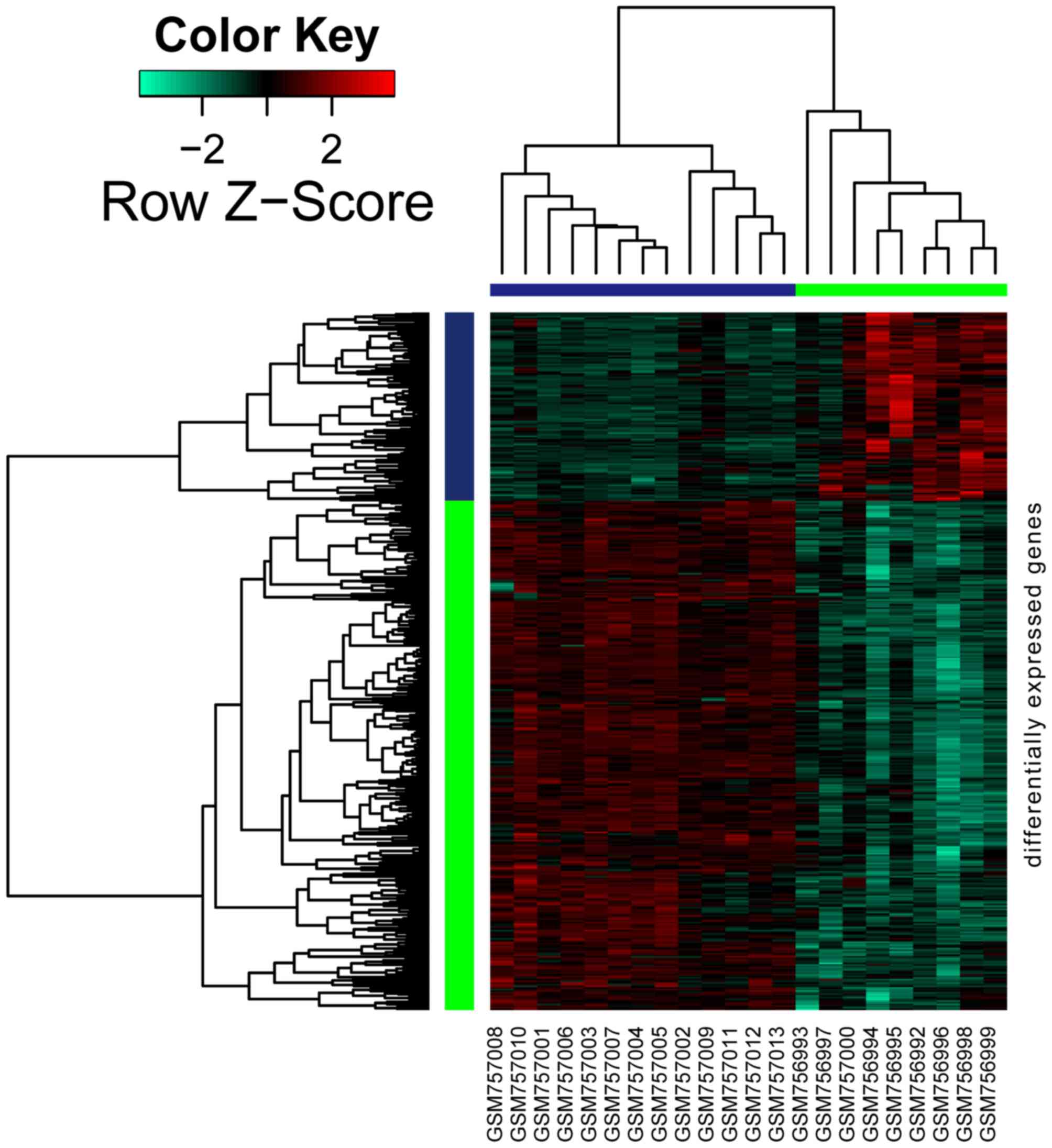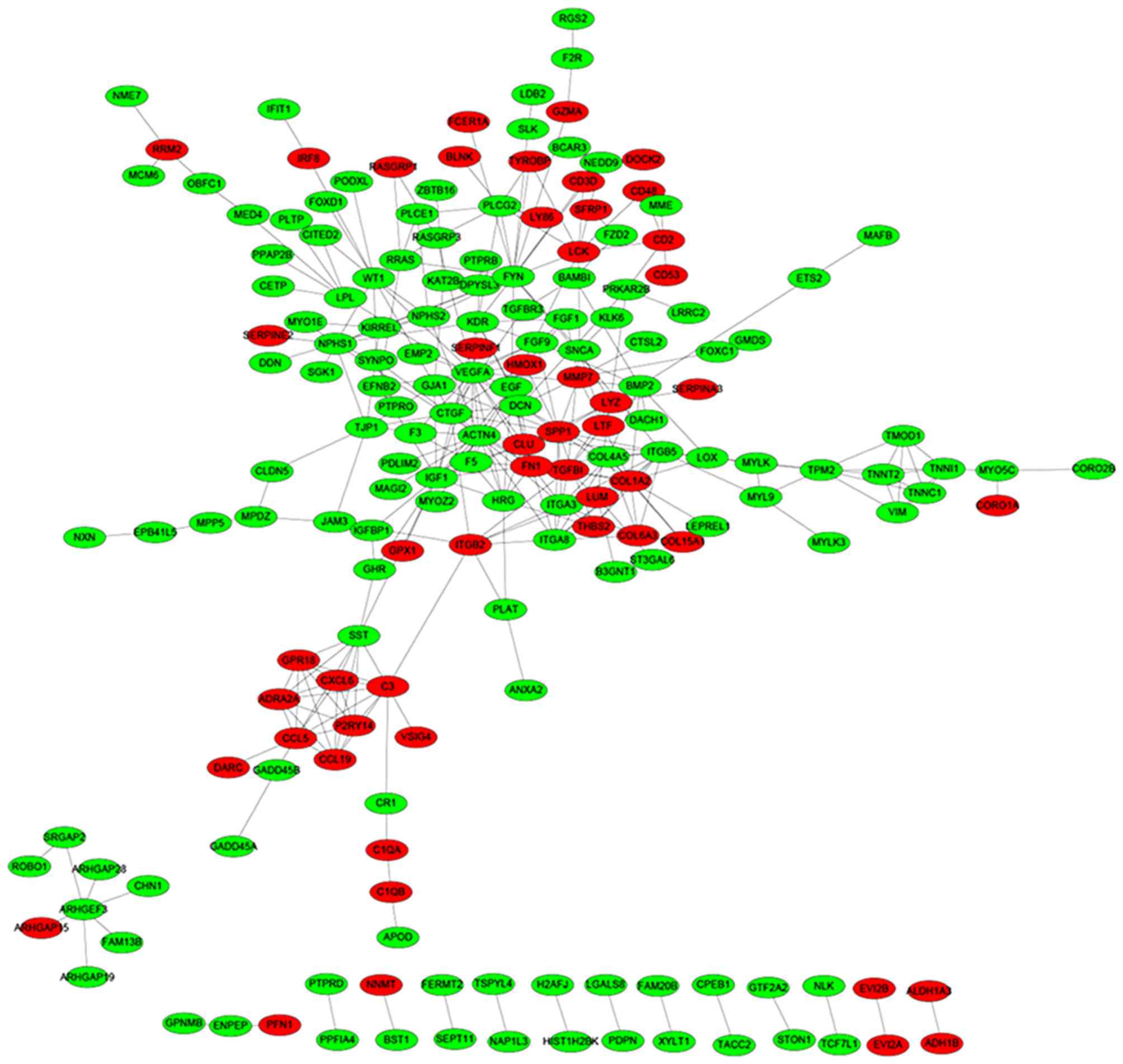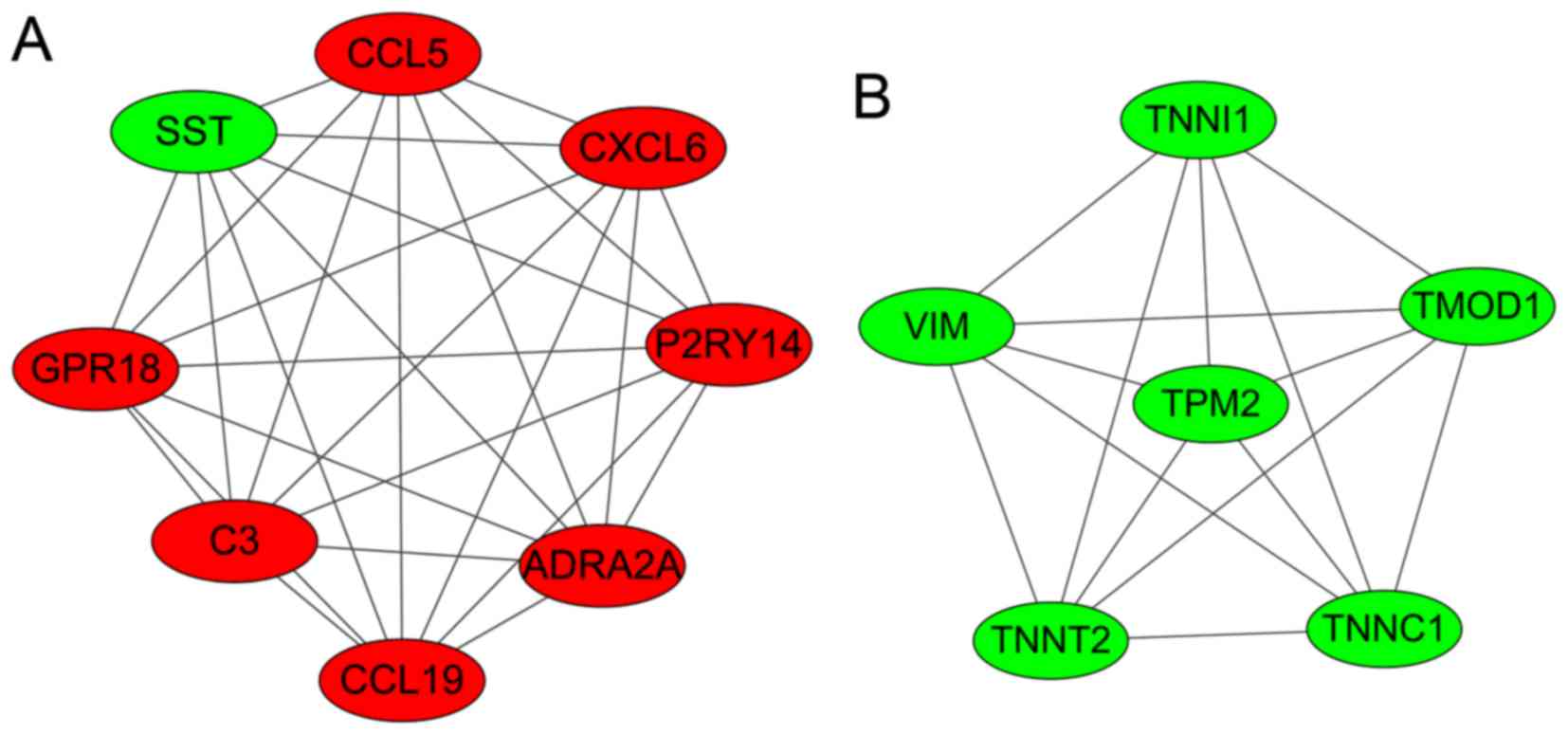|
1
|
Association AD: Standards of medical care
in diabetes-2010. Diabetes care. 33 Suppl:S11–S61. 2010. View Article : Google Scholar :
|
|
2
|
Levin A and Rocco M: KDOQI clinical
practice guidelines and clinical practice recommendations for
diabetes and chronic kidney disease. Am J Kidney Dis. 49(2 Suppl
2): S12–S154. 2007.
|
|
3
|
Woroniecka KI, Park AS, Mohtat D, Thomas
DB, Pullman JM and Susztak K: Transcriptome analysis of human
diabetic kidney disease. Diabetes. 60:2354–2369. 2011. View Article : Google Scholar :
|
|
4
|
Susztak K, Raff AC, Schiffer M and
Böttinger EP: Glucose-induced reactive oxygen species cause
apoptosis of podocytes and podocyte depletion at the onset of
diabetic nephropathy. Diabetes. 55:225–233. 2006. View Article : Google Scholar
|
|
5
|
Langham RG, Kelly DJ, Cox AJ, Thomson NM,
Holthöfer H, Zaoui P, Pinel N, Cordonnier DJ and Gilbert RE:
Proteinuria and the expression of the podocyte slit diaphragm
protein, nephrin, in diabetic nephropathy: Effects of angiotensin
converting enzyme inhibition. Diabetologia. 45:1572–1576. 2002.
View Article : Google Scholar
|
|
6
|
Doublier S, Salvidio G, Lupia E,
Ruotsalainen V, Verzola D, Deferrari G and Camussi G: Nephrin
expression is reduced in human diabetic nephropathy: Evidence for a
distinct role for glycated albumin and angiotensin II. Diabetes.
52:1023–1030. 2003. View Article : Google Scholar
|
|
7
|
Koop K, Eikmans M, Baelde HJ, Kawachi H,
de Heer E, Paul LC and Bruijn JA: Expression of podocyte-associated
molecules in acquired human kidney diseases. J Am Soc Nephrol.
14:2063–2071. 2003. View Article : Google Scholar
|
|
8
|
Turk T, Leeuwis JW, Gray J, Torti SV,
Lyons KM, Nguyen TQ and Goldschmeding R: BMP signaling and podocyte
markers are decreased in human diabetic nephropathy in association
with CTGF overexpression. J Histochem Cytochem. 57:623–631. 2009.
View Article : Google Scholar :
|
|
9
|
Lindenmeyer MT, Kretzler M, Boucherot A,
Berra S, Yasuda Y, Henger A, Eichinger F, Gaiser S, Schmid H,
Rastaldi MP, et al: Interstitial vascular rarefaction and reduced
VEGF-A expression in human diabetic nephropathy. J Am Soc Nephrol.
18:1765–1776. 2007. View Article : Google Scholar
|
|
10
|
Hohenstein B, Hausknecht B, Boehmer K,
Riess R, Brekken RA and Hugo CP: Local VEGF activity but not VEGF
expression is tightly regulated during diabetic nephropathy in man.
Kidney Int. 69:1654–1661. 2006. View Article : Google Scholar
|
|
11
|
Nath KA: The tubulointerstitium in
progressive renal disease. Kidney Int. 54:992–994. 1998. View Article : Google Scholar
|
|
12
|
Gilbert RE and Cooper ME: The
tubulointerstitium in progressive diabetic kidney disease: More
than an aftermath of glomerular injury? Kidney Int. 56:1627–1637.
1999. View Article : Google Scholar
|
|
13
|
Strippoli GF, Craig M, Deeks JJ, Schena FP
and Craig JC: Effects of angiotensin converting enzyme inhibitors
and angiotensin II receptor antagonists on mortality and renal
outcomes in diabetic nephropathy: Systematic review. BMJ.
329:8282004. View Article : Google Scholar :
|
|
14
|
Hansen TK, Forsblom C, Saraheimo M, Thorn
L, Wadén J, Høyem P, Østergaard J, Flyvbjerg A and Groop PH;
FinnDiane Study Group, : Association between mannose-binding
lectin, high-sensitivity C-reactive protein and the progression of
diabetic nephropathy in type 1 diabetes. Diabetologia.
53:1517–1524. 2010. View Article : Google Scholar : PubMed/NCBI
|
|
15
|
Gautier L, Cope L, Bolstad BM and Irizarry
RA: affy-analysis of Affymetrix GeneChip data at the probe level.
Bioinformatics. 20:307–315. 2004. View Article : Google Scholar : PubMed/NCBI
|
|
16
|
Ritchie ME, Phipson B, Wu D, Hu Y, Law CW,
Shi W and Smyth GK: Limma powers differential expression analyses
for RNA-sequencing and microarray studies. Nucleic Acids Res.
43:e472015. View Article : Google Scholar : PubMed/NCBI
|
|
17
|
Ashburner M, Ball CA, Blake JA, Botstein
D, Butler H, Cherry JM, Davis AP, Dolinski K, Dwight SS, Eppig JT,
et al: Gene ontology: Tool for the unification of biology. The Gene
Ontology Consortium. Nat Genet. 25:25–29. 2000. View Article : Google Scholar : PubMed/NCBI
|
|
18
|
Altermann E and Klaenhammer TR:
PathwayVoyager: Pathway mapping using the Kyoto Encyclopedia of
Genes and Genomes (KEGG) database. BMC Genomics. 6:602005.
View Article : Google Scholar : PubMed/NCBI
|
|
19
|
Wang J, Zhou X, Zhu J, Gu Y, Zhao W, Zou J
and Guo Z: GO-function: Deriving biologically relevant functions
from statistically significant functions. Brief Bioinform.
13:216–227. 2012. View Article : Google Scholar : PubMed/NCBI
|
|
20
|
Szklarczyk D, Franceschini A, Kuhn M,
Simonovic M, Roth A, Minguez P, Doerks T, Stark M, Muller J, Bork
P, et al: The STRING database in 2011: Functional interaction
networks of proteins, globally integrated and scored. Nucleic Acids
Res. 39:D561–D568. 2011. View Article : Google Scholar : PubMed/NCBI
|
|
21
|
Kohl M, Wiese S and Warscheid B:
Cytoscape: Software for visualization and analysis of biological
networks. Methods Mol Biol. 696:291–303. 2011. View Article : Google Scholar : PubMed/NCBI
|
|
22
|
Ichinose K, Kawasaki E and Eguchi K:
Recent advancement of understanding pathogenesis of type 1 diabetes
and potential relevance to diabetic nephropathy. Am J Nephrol.
27:554–564. 2007. View Article : Google Scholar : PubMed/NCBI
|
|
23
|
Galkina E and Ley K: Leukocyte recruitment
and vascular injury in diabetic nephropathy. J Am Soc Nephrol.
17:368–377. 2006. View Article : Google Scholar : PubMed/NCBI
|
|
24
|
Chow F, Ozols E, Nikolic-Paterson DJ,
Atkins RC and Tesch GH: Macrophages in mouse type 2 diabetic
nephropathy: Correlation with diabetic state and progressive renal
injury. Kidney Int. 65:116–128. 2004. View Article : Google Scholar : PubMed/NCBI
|
|
25
|
Tuttle KR: Linking metabolism and
immunology: Diabetic nephropathy is an inflammatory disease. J Am
Soc Nephrol. 16:1537–1538. 2005. View Article : Google Scholar : PubMed/NCBI
|
|
26
|
Mora C and Navarro JF: Inflammation and
diabetic nephropathy. Curr Diab Rep. 6:463–468. 2006. View Article : Google Scholar : PubMed/NCBI
|
|
27
|
Johnston SL, Virgo PF and Unsworth DJ:
Type 1 diabetes mellitus masking primary antibody deficiency. J
Clin Pathol. 53:236–237. 2000. View Article : Google Scholar : PubMed/NCBI
|
|
28
|
Prevoo ML, Van't Hof MA, Kuper HH, Van
Leeuwen MA, Van de Putte LB and Van Riel PL: Modified disease
activity scores that include twenty-eight-joint counts, development
and validation in a prospective longitudinal study of patients with
rheumatoid arthritis. Arthritis Rheum. 38:44–48. 1995. View Article : Google Scholar : PubMed/NCBI
|
|
29
|
Feng PH: Systemic lupus erythematosus: the
face of Asia. Ann N Y Acad Sci. 1108:114–120. 2007. View Article : Google Scholar : PubMed/NCBI
|
|
30
|
Varney MD, Valdes AM, Carlson JA, Noble
JA, Tait BD, Bonella P, Lavant E, Fear AL, Louey A, Moonsamy P, et
al: HLA DPA1, DPB1 alleles and haplotypes contribute to the risk
associated with type 1 diabetes: Analysis of the type 1 diabetes
genetics consortium families. Diabetes. 59:2055–2062. 2010.
View Article : Google Scholar : PubMed/NCBI
|
|
31
|
Santin I, Castellanos-Rubio A, Aransay AM,
Gutierrez G, Gaztambide S, Rica I, Vicario JL, Noble JA, Castaño L
and Bilbao JR: Exploring the diabetogenicity of the HLA-B18-DR3
CEH: Independent association with T1D genetic risk close to
HLA-DOA. Genes Immun. 10:596–600. 2009. View Article : Google Scholar : PubMed/NCBI
|
|
32
|
Dvorak HF, Brown LF, Detmar M and Dvorak
AM: Vascular permeability factor/vascular endothelial growth
factor, microvascular hyperpermeability, and angiogenesis. Am J
Pathol. 146:1029–1039. 1995.PubMed/NCBI
|
|
33
|
Schrijvers BF, Flyvbjerg A and De Vriese
AS: The role of vascular endothelial growth factor (VEGF) in renal
pathophysiology. Kidney Int. 65:2003–2017. 2004. View Article : Google Scholar : PubMed/NCBI
|
|
34
|
Baelde HJ, Eikmans M, Doran PP, Lappin DW,
de Heer E and Bruijn JA: Gene expression profiling in glomeruli
from human kidneys with diabetic nephropathy. Am J Kidney Dis.
43:636–650. 2004. View Article : Google Scholar : PubMed/NCBI
|
|
35
|
Bortoloso E, Del Prete D, Vestra M Dalla,
Gambaro G, Saller A, Antonucci F, Baggio B, Anglani F and Fioretto
P: Quantitave and qualitative changes in vascular endothelial
growth factor gene expression in glomeruli of patients with type 2
diabetes. Eur J Endocrinol. 150:799–807. 2004. View Article : Google Scholar : PubMed/NCBI
|
|
36
|
Cha DR, Kim NH, Yoon JW, Jo SK, Cho WY,
Kim HK and Won NH: Role of vascular endothelial growth factor in
diabetic nephropathy. Kidney Int Suppl. 77:S104–S112. 2000.
View Article : Google Scholar : PubMed/NCBI
|
|
37
|
Eremina V, Sood M, Haigh J, Nagy A, Lajoie
G, Ferrara N, Gerber HP, Kikkawa Y, Miner JH and Quaggin SE:
Glomerular-specific alterations of VEGF-A expression lead to
distinct congenital and acquired renal diseases. J Clin Invest.
111:707–716. 2003. View
Article : Google Scholar : PubMed/NCBI
|
|
38
|
Caldwell RB, Bartoli M, Behzadian MA,
El-Remessy AE, Al-Shabrawey M, Platt DH and Caldwell RW: Vascular
endothelial growth factor and diabetic retinopathy:
Pathophysiological mechanisms and treatment perspectives. Diabetes
Metab Res Rev. 19:442–455. 2003. View
Article : Google Scholar : PubMed/NCBI
|
|
39
|
Nikolopoulos SN, Spengler BA, Kisselbach
K, Evans AE, Biedler JL and Ross RA: The human non-muscle
alpha-actinin protein encoded by the ACTN4 gene suppresses
tumorigenicity of human neuroblastoma cells. Oncogene. 19:380–386.
2000. View Article : Google Scholar : PubMed/NCBI
|
|
40
|
HA TS: High glucose and advanced
glycosylated end-products affect the expression of alpha-actinin-4
in glomerular epithelial cells. Nephrology (Carlton). 11:435–441.
2006. View Article : Google Scholar : PubMed/NCBI
|
|
41
|
Jefferson JA, Shankland SJ and Pichler RH:
Proteinuria in diabetic kidney disease: A mechanistic viewpoint.
Kidney Int. 74:22–36. 2008. View Article : Google Scholar : PubMed/NCBI
|
|
42
|
Resh MD: Fyn, a Src family tyrosine
kinase. Int J Biochem Cell Biol. 30:1159–1162. 1998. View Article : Google Scholar : PubMed/NCBI
|
|
43
|
Taniguchi K, Xia L, Goldberg HJ, Lee KW,
Shah A, Stavar L, Masson EA, Momen A, Shikatani EA, John R, et al:
Inhibition of Src kinase blocks high glucose-induced EGFR
transactivation and collagen synthesis in mesangial cells and
prevents diabetic nephropathy in Mice. Diabetes. 62:3874–3886.
2013. View Article : Google Scholar : PubMed/NCBI
|
|
44
|
van Nieuw Amerongen GP and van Hinsbergh
VW: Targets for pharmacological intervention of endothelial
hyperpermeability and barrier function. Vascular pharmacol.
39:257–272. 2002. View Article : Google Scholar
|
|
45
|
Kato M, Zhang J, Wang M, Lanting L, Yuan
H, Rossi JJ and Natarajan R: MicroRNA-192 in diabetic kidney
glomeruli and its function in TGF-beta-induced collagen expression
via inhibition of E-box repressors. Proc Natl Acad Sci USA. 104:pp.
3432–3437. 2007; View Article : Google Scholar : PubMed/NCBI
|
|
46
|
Kato M, Arce L and Natarajan R: MicroRNAs
and their role in progressive kidney diseases. Clin J Am Soc
Nephrol. 4:1255–1266. 2009. View Article : Google Scholar : PubMed/NCBI
|
|
47
|
Ewens KG, George RA, Sharma K, Ziyadeh FN
and Spielman RS: Assessment of 115 candidate genes for diabetic
nephropathy by transmission/disequilibrium test. Diabetes.
54:3305–3318. 2005. View Article : Google Scholar : PubMed/NCBI
|
|
48
|
Schreiber B, Hughes M and Groggel G:
Insulin-like growth factor-1 stimulates production of mesangial
cell matrix components. Clin Nephrol. 43:368–374. 1995.PubMed/NCBI
|













